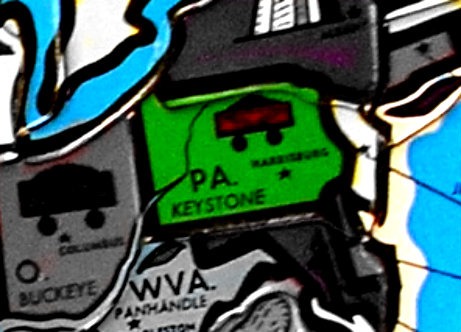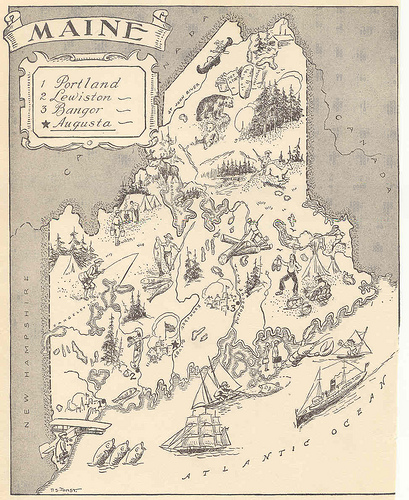Radioactive Waste 17 - BRC Recommendations
In the previous post, I talked about the Blue Ribbon Commission on America’s Nuclear Future. On December 12, 2011 before the release of its final report, the BRC sent a letter Secretary of Energy and President Obama.
One of the things that the letter emphasizes is that the President should move as soon as possible to makes changes with the Nuclear Waste Fund collected as fees on nuclear utilities. The letter says that the Commission learned in its investigation of the NWF that the fund is not working as intended. They charge that actions by the Executive Branch and Congress have made the twenty seven billion dollars in the NWF unavailable for the current nuclear waste management program. The intent of the creation of the NWF was to reserve money for nuclear waste management and keep it out of the annual budget fight for funding that most Federal programs are subjected to. Without access to the NWF, nuclear waste management now does have to fight for a share of the Federal budget to do its work.
Under the current contract, the government is collecting seven hundred fifty million per year from nuclear utilities. Since the passing of the deadline for a U.S. nuclear waste repository in 1998 to take spent nuclear fuel, utilities have successfully sued the U.S. government for violation of contract and government liabilities may climb to sixteen billion dollars under the present contract.
The Commission letter suggests that the President move to amend the standard nuclear waste contract with nuclear utilities so that the utilities are only required to pay a fee to cover the current temporary storage of spent nuclear fuels. At the same time, Congress should change the budgetary treatment of the fees collected from nuclear utilities to divert them from a permanent disposal solution to temporary disposal management. The Commission requests that these actions be undertaken for the Fiscal Year 2013 budget proposal.
The Commission recognizes that there would be an impact on the national deficit because the current seven hundred fifty million dollars being collected is used to decrease the annual deficit. On the other hand, the Commission points out that the mounting costs of fines and litigations from utility lawsuits are increasing the deficit. If these changes are made to the NWF, then current nuclear waste management could be reliably funded and the lawsuits from nuclear utilities would end.
The Commission letter mentions that it worked with both advocates for the taxpayers concerned about the permanent disposal of spent nuclear fuel and the industry associations that are advocating for expanding nuclear. Both of these groups support the recommendations outlined in the letter and detailed in the final report from the Commission delivered on January 26, 2012. Even though the report lacked specifics for dealing with permanent spent nuclear waste disposal, the recommendations in the report and the letter are an important first step.
Spent nuclear fuel cask on a railcar:
Radioactive Waste 16 - Blue Ribbon Presidential Commission
Before the Obama administration moved to cancel the Yucca Mountain Repository Project for permanent storage of high-level nuclear waste in March of 2010, the President created the Blue Ribbon Commission on America’s Nuclear Future to study the problem of permanent spent nuclear fuel disposal on January 29, 2010. The Commission was co-chaired by former Congressman Lee Hamilton and former National Security Advisor Brent Scowcroft. The Commission was not told to select a site or to prefer one type of solution over another. As the saying goes, “everything was on the table,” except for Yucca Mountain, of course.
In the words of the memoranda establishing the Commission, “The Commission should conduct a comprehensive review of policies for managing the back end of the nuclear fuel cycle, including all alternatives for the storage, processing, and disposal of civilian and defense used nuclear fuel and nuclear waste. This review should include an evaluation of advanced fuel cycle technologies that would optimize energy recovery, resource utilization, and the minimization of materials derived from nuclear activities in a manner consistent with U.S. nonproliferation goals.”
The Commission was charged to consider scientific, environmental, budgetary, economic, financial and management issues. The Commission was also supposed to consider any important statutory changes that it deemed necessary. The Commission was told to come back in 18 months with a draft report and to make that report available for public review and input. A final report was to be delivered within 24 months. These activities were to be carried out under the authority of the Department of Energy.
There is some boilerplate in the memoranda to the effect that no agency or business is required to disclose sensitive information protected by law. The Commission’s work also was not intended to create any right, benefit or penalty for any entity with respect to the U.S. Government, its agencies, officers or employees.
The Commission met dozens of times over the next two years to hear testimony from experts and stakeholder. They visited nuclear waste management facilities in the United States and abroad. Many different organizations, interest groups and individuals came to the Commission to offer their perspective on the issues before the Commission. Copies of all the submissions and all reports issued by the Commission are available on the Commission’s website.
The draft report was turned in on July 29, 2011 and was almost two hundred pages. The final 180 page report of the commission was presented to the Secretary of Energy on January 26, 2012. The report was accompanied by a letter to the Secretary summarizing the key points of the report and the Commission’s recommendations. Some critics have charged that the Commission spent too much time dwelling on the failure of the governments efforts to solve the nuclear waste disposal problem to date and not enough on finding new solutions. They have also charged that the Commission’s recommendations are too broad and do not offer details on a viable disposal alternative.
Senate Race Update: Pennsylvania
Most election years have at least one "shocker" in which the voters do what is genuinely (or at least generally) unexpected. The potential for a "shocker" is certainly brewing in the Pennsylvania U.S. Senate race, where challenger Tom Smith (R) looks to be a real contender to dislodge Sen. Bob Casey (D).
Some typical hallmarks of a "shocker" are present in this race:
1. A "fresh face"
Sen. Scott Brown was dynamic candidate rolling into town in a pickup truck, whose opponent (Attorney General Martha Coakley), while not an incumbent, seemed part of a tired establishment. Brown surged late to score a major upset.
Likewise, Minnesota's Paul Wellstone was an underdog college professor who ran a humor-based grass roots campaign. Two years later, young state senator Russ Feingold of neighboring Wisconsin replicated Wellstone's "fresh face" underdog success.
But then 18 years later, it was newcomer businessman Ron Johnson who ousted Feingold with an underdog campaign of his own, this time emerging from conservative grass roots.
2. An overrated candidate "coasting"
Sometimes candidates believe their own press clippings. Sometimes, circumstances lead them to think they're in better shape than they are. Sometimes they just are not predisposed to work that hard.
3. Some sort of national "wave"
Although not always, many times a "shocker" will get support from a national trend. In the Reagan landslide of 1980, a whole bunch of Democrats were unseated, including the late George McGovern, who passed on this week, and Birch Bayh (who was knocked off by then-"fresh face" Dan Quayle).
Do we see a "shocker" brewing? This much we know:
- Smith is a "fresh face," having been completely uninvolved in politics until 2010. In fact, he was a registered Democrat until that time.
- Smith is playing off his "fresh"-ness to his advantage with a massive self-funded advertising campaign.
- Casey and national Democrats "got in the game" late, after having underestimated Smith's appeal.
- Casey looked strong on paper, but, in reality, had run only one fiercely competitive race ... in which he lost badly in the 2002 Democratic primary for governor to eventual winner Ed Rendell, then mayor of Philadelphia.
- In his other races, Casey was helped by affection for his family (his father was governor) and by the coincidental collapse of support for former Sen. Rick Santorum in a massively Democratic year (2006).
- There does not appear to be a Reagan-level national wind blowing for the GOP this year, but Mitt Romney's appeal to centrist independent voters appears to be making states like Pennsylvania more competitive. If those voters turn out (which is uncertain), then upsets will surely result.
All of which doesn't mean that Casey is likely to lose, only that the hallmarks of an upset are there, and a Smith victory, should it happen, will be one of the biggest stories of the night.
Maine Rules the World, Part II
Awhile back we considered the possibility that the U.S. Senate would end in a virtual tie, with the balance of power held by Maine frontrunner candidate Angus King.
King is running as an independent, but the political universe assumes he will caucus as a Democrat. Except that King says that's not necessarily so, and, if, in fact, the balance of power hinged on his vote, would he really just give it up without even a conversation about what his options are?
I don't think so.
But apparently that's not the end of the possibilities for Maine tipping the balance in 2012.
With Mitt Romney gaining among centrist independent voters following the first presidential debate, the GOP looks to be competitive in places where it was not expected to be. One of those places is Wisconsin, where the Republicans won key Senate and gubernatorial races in 2010, and then prevailed in a hard-fought recall election in 2012.
Another place is New Hampshire, which is filled with voters who may not warm up to the Sun Belt version of the GOP, but are old-school Yankee conservative in the "Live Free or Die" kind of way (that's the motto on the New Hampshire license plates, if you don't know).
Same thing with Maine (at least the parts thereof that aren't part of the trendy urban coastal area).
So ... suddenly Romney is presented with a means by which to "end run" the famed Obama "firewall" based in Ohio.
Here's a link to what the map would look like. Romney takes Iowa and Wisconsin with a boost from independent but conservative-oriented voters there, and also storms into the Northeast and takes the Granite State. That would leave the entire election up to: the 2nd Congressional District of Maine.
Maine, you see, splits its electoral votes by congressional district. All of those hipster urban areas are in the 1st District. The 2nd District is rural and old-school New England independent. And, a poll released on October 15 showed Romney in the lead there.
So Romney could pick up the deciding vote in Maine ... or President Obama could. But it would all come down to that one vote.
[A Romney win there would force a tie, which would be decided by the House of Represenatives voting by state delegations. Due to Republican control of those state delegations, most observers figure that the House would elect Romney. So, in effect, a tie goes to Romney.]
Of course, it's much more likely that Ohio will swing the balance. But with Romney gaining nationally, and polls in the Buckeye state being more "sticky' than most (for whatever reason ... some suggest lingering union solidarity resulting from unique Ohio labor issues not influencing other states), Romney will obviously be looking for a way to win without Ohio.
One of those routes runs through Maine.
Use the bottom line to make things happen
Recently I was having a pleasant conversation among a group of moms about how it was so cool that we could still get along even though we were all from different faiths, if any. We agreed that it would be fun to share these faiths with our group of homeschoolers and help educate our children about various cultures and lifestyles.
Then one mom turned the conversation toward the Chik-Fil-A boycott, and everyone but me chimed in about how stupid it was to stage a kiss-in, or even a boycott. “That’s what children do,” one mom remarked, and I couldn’t get out of the discussion fast enough because I knew I was going to say something I’d regret.I said it anyway. “That’s how change is made, though. By refusing to buy something. Just think if the Alabama bus boycotts hadn’t happened.” I received two blank looks while the other mom wouldn’t look at me, and I started to wonder if they approved of segregated bus rides, too. After all, not allowing LGBT people to marry falls into that same line of thinking.
These women are my friends, and I’ll give them the benefit of the doubt that they truly believe whatever they do is for the good of their families and the world. But I have to wonder what they think you should do to enact change if they think boycotts are for children (what a strange idea, anyway, right?).
Maybe their answer would be to pray. I’m the only member of this small group who doesn’t subscribe to one of the Big Three book religions—in fact, all three subscribe to some sect of one, as a hefty helping of this country does—though there are a few others like me in the larger circle. I know that praying is what they do if someone is suffering or comes down ill, and don’t get me wrong, I’m grateful to receive such kind thoughts—but you can’t simply leave everything up to the invisible cloud man without doing something yourself, too. Otherwise, why not just send your kids to school, anyway, and then pray that they get everything that you want them to?
Again, I mean no disrespect. I just would love the same respect for everyone else who is trying to achieve goals with actual physical work—the same kind that we had originally started our conversation about religion with.
Disney Books: Save 52%
Get a pair of custom Disney books, regularly priced at $45, for just $22 with this online deal. Shipping included in offer. Up to five sets may be purchased per buyer.
Chili's: FREE Sides with Every Group Order
Get a fajita deal for $5.50 per person at select Chili's locations during game days and receive free rice, beans, and chips and salsa with your order for a party of eight or more. Offer valid through November 2, 2012.
Butter Rum Life Savers
It's not often you find a candy that is flavored like an alcoholic beverage. And what IS "butter rum" anyway? These were my two thoughts, right before I snatched up a roll of Butter Rum Life Savers at the checkout line and sheepishly tossed it onto the conveyor belt along with my other (healthier, I swear) foods.
Pulling At My Heartstrings: Guilty Dog Is Guilty and more cute dumps
90s style: Big boots and floral-print dresses
This look was probably made most famous by Bridget Fonda in the movie "Singles." But I can actually remember the exact moment when I became aware of this fashion statement. It was 1993, and I was watching "Warlock 2: The Armageddon" in the movie theater, and I kept getting distracted from the plot (what little there was of it) by the heroine's outfit.






